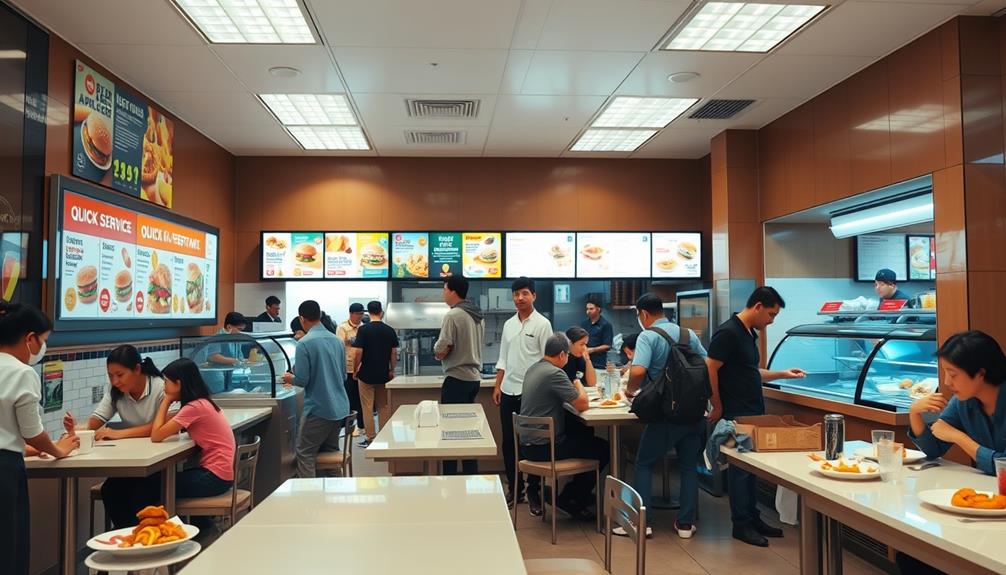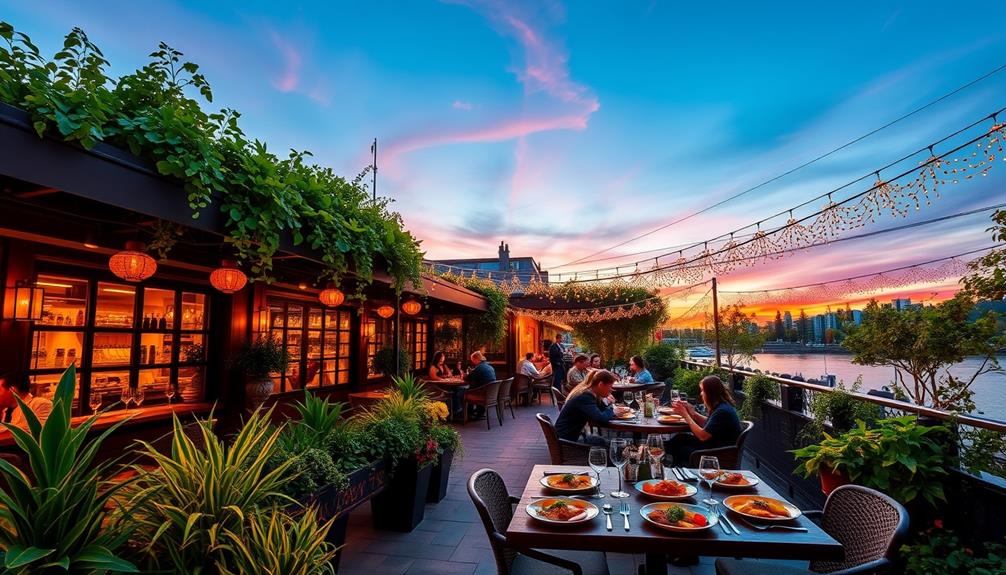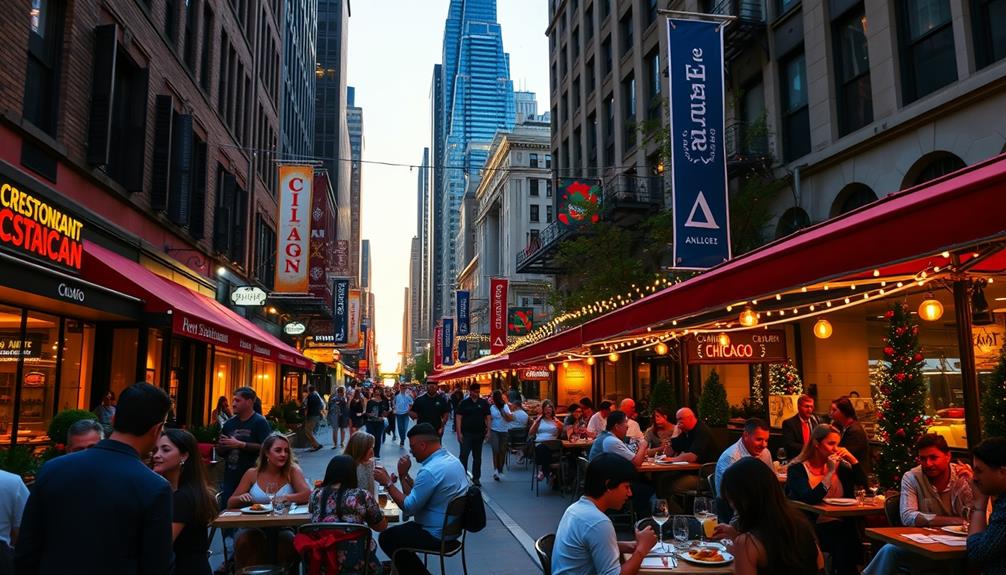A Quick Service Restaurant (QSR) is all about providing meals swiftly and affordably, usually under $10. You'll find a limited menu designed for quick preparation and self-service options like kiosks that enhance efficiency. Many people opt for takeout or drive-thru service, making QSRs perfect for those on the go. Unlike fast casual spots, QSRs focus on speed, serving meals in just a few minutes. With a growing market and innovative technology, they cater to changing consumer preferences. If you're curious about the trends shaping this industry, there's much more to explore.
Key Takeaways
- Quick Service Restaurants (QSRs) focus on delivering meals quickly, typically preparing food for immediate delivery in 2 to 5 minutes.
- QSRs offer a limited menu with items priced at $10 or less, emphasizing affordability and efficiency.
- The dining atmosphere in QSRs is fast-paced, designed for quick meals or takeout, unlike the relaxed vibe of Fast Casual restaurants.
- QSRs utilize self-service models and technology, such as kiosks and mobile apps, to enhance speed and customer convenience.
- High customer turnover and lower operating costs make QSRs attractive for entrepreneurs, with profit margins ranging between 6% and 9%.
Definition of Quick Service Restaurants
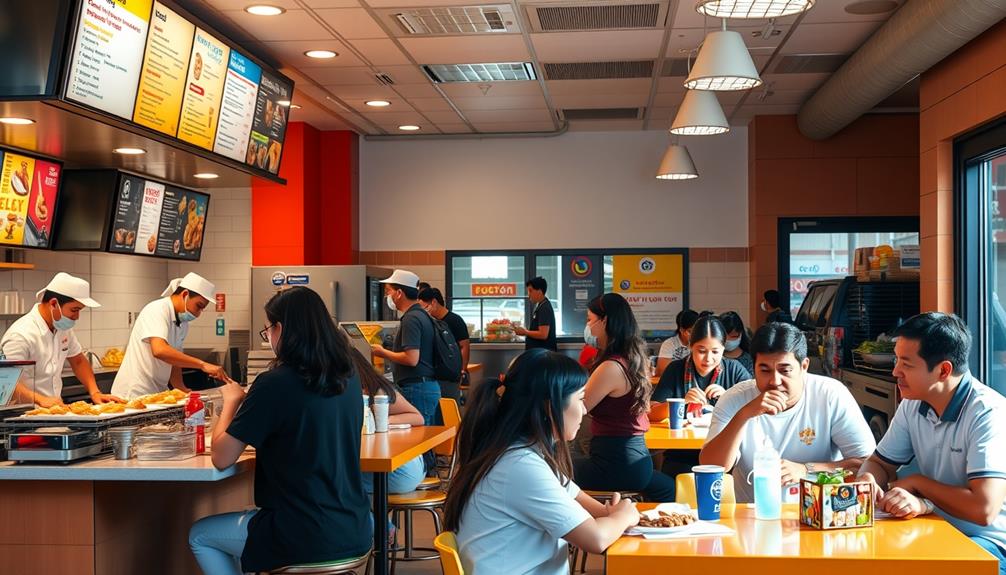
Quick Service Restaurants (QSRs), often known as fast food restaurants, focus on delivering meals quickly and efficiently. These establishments typically feature a limited menu with items priced at $10 or less, allowing you to grab a bite without breaking the bank.
When you walk into a QSR, you'll notice the self-service model where you order at a counter or kiosk, streamlining the service process. This operational efficiency is similar to the importance of a well-structured budget, as it helps manage resources effectively.
The dining experience at QSRs emphasizes speed, making it a popular choice for those on the go. Many QSRs also provide takeout options and drive-thru services, catering to customers who prefer not to dine in.
The convenience of fast food is evident, as over 25% of adults in the U.S. consume these meals daily.
Major players like McDonald's, Subway, and KFC dominate the market, benefiting from strong brand recognition and customer loyalty. QSRs prioritize efficiency and consistency, ensuring that meals are prepared uniformly across different locations.
This reliability in service and menu items contributes greatly to the projected growth of the fast food market, expected to reach $300 billion by 2025.
Key Features of QSRs
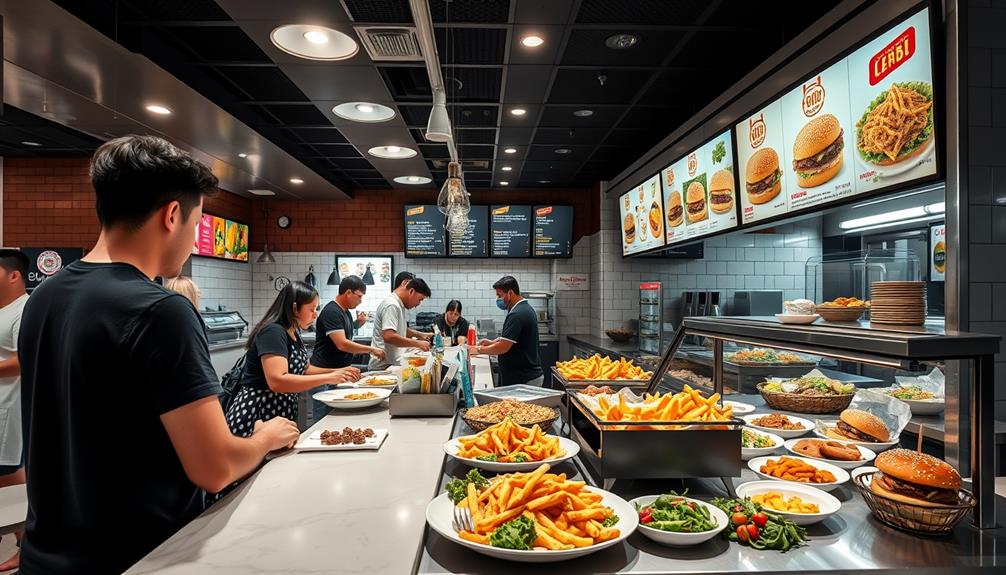
QSRs are characterized by several key features that set them apart from other dining options. First and foremost, these Quick-Service Restaurants offer simple menus focusing on specific food types, which allows for quick preparation and minimal customization. Meals typically cost less than $10, providing affordable options for those seeking value.
Here's a quick overview of the key features:
| Feature | Description | Benefit |
|---|---|---|
| Self-Service Kiosks | Customers order and pay before eating | Increases efficiency |
| Takeout and Delivery | Emphasis on convenience with limited dining space | Meets customer demand for ease |
| Standardized Preparation | Uniform cooking methods across locations | Guarantees consistent quality |
| Diverse Customer Base | Appeals to a wide range of consumers | Broadens market reach |
Differences From Fast Casual Restaurants
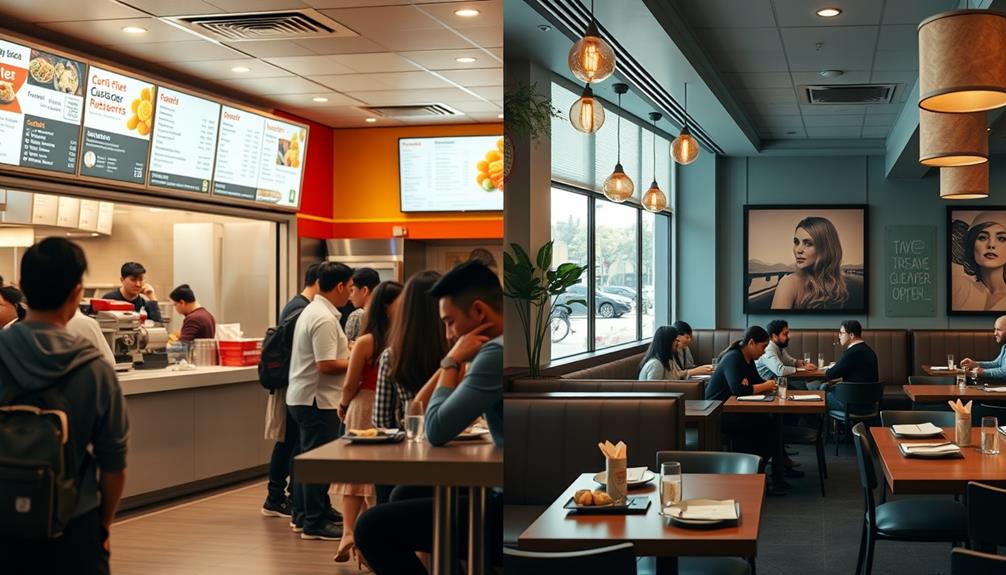
When you compare Quick Service Restaurants (QSRs) to Fast Casual spots, you'll notice some key differences.
QSRs focus on speed with limited menu options, which aligns with the swift service needed during busy hours, while Fast Casual restaurants offer more flexibility and customization in their meals.
Additionally, the casual dining experience allows for a more engaging atmosphere, often incorporating elements that enhance customer comfort, similar to how cozy environments are fostered in home offices.
Plus, the dining atmosphere shifts from the fast-paced environment of QSRs to the more relaxed vibe of Fast Casual establishments.
Menu Flexibility Comparison
The menu flexibility in Quick Service Restaurants (QSRs) starkly contrasts with that of Fast Casual restaurants, showcasing a clear division in dining experiences.
QSRs typically feature a limited range of standardized items designed for quick preparation and service. You'll notice that these restaurants focus on speed of service, often serving pre-cooked meals ready for immediate delivery, which is akin to the efficiency sought in New England camping experiences. This approach allows for efficient customer turnover but limits your options.
In contrast, Fast Casual restaurants offer a wider variety of customizable options that cater to different tastes. Their menus often include fresh, made-to-order meals that take longer to prepare, enhancing the overall dining experience.
While QSRs maintain consistency across locations with minimal menu variations, Fast Casual spots might experiment with seasonal or regional items, giving you more choices.
Moreover, the average price point at QSRs hovers around $10 or less, making them more budget-friendly compared to Fast Casual restaurants, where meals typically cost more due to their diverse offerings.
Service Speed Differences
Speed of service is a defining characteristic of Quick Service Restaurants (QSRs), setting them apart from Fast Casual dining. In QSRs, meals are prepared for immediate delivery, allowing you to enjoy fast service that typically takes just 2 to 5 minutes. This rapid turnaround is essential for maintaining high customer turnover, a strategy that aligns with content relevance and authority.
This is a stark contrast to Fast Casual restaurants, where made-to-order meals can take 10 to 15 minutes. QSRs often utilize a self-service model, letting you place orders at counters or kiosks for quick food delivery.
Another key difference lies in the ordering system. While QSRs emphasize efficiency, Fast Casual spots might offer table service elements that slow down the process and create a more relaxed dining atmosphere.
If you're looking for a speedy meal on the go, QSRs are designed for high customer turnover, serving as many guests as possible during peak hours. Plus, the inclusion of drive-thru services in QSRs means you can grab your meal without even leaving your vehicle, which is a convenience often missing in Fast Casual dining options.
Dining Atmosphere Contrast
How does the dining atmosphere in Quick Service Restaurants (QSRs) differ from that of Fast Casual restaurants?
QSRs focus on speed and efficiency, typically featuring a self-service model with limited seating. You'll notice that the dining atmosphere is more functional, catering primarily to those looking for quick meals or takeout options. In many cases, QSRs also capitalize on convenience by integrating innovative coffee gear and accessories, appealing to customers who may want a quick caffeine fix alongside their meals, as seen in coffee culture.
In contrast, Fast Casual restaurants create a more relaxed environment, encouraging you to sit back and enjoy your meal with ample seating and a focus on customer experience.
When you choose QSRs, you're often looking for budget-friendly meals, with average price points around $10 or less. Fast Casual establishments generally have higher price points, offering more elaborate menu options and a leisurely dining experience.
While QSRs excel in serving high volumes of customers rapidly, they don't emphasize on-premise dining as much as Fast Casual spots do. In a Fast Casual restaurant, you're likely to find a wider selection of customizable menu items, which require more preparation time.
Ultimately, the dining atmosphere in QSRs prioritizes speed, while Fast Casual restaurants invite you to linger and savor your meal.
Benefits of Operating a QSR
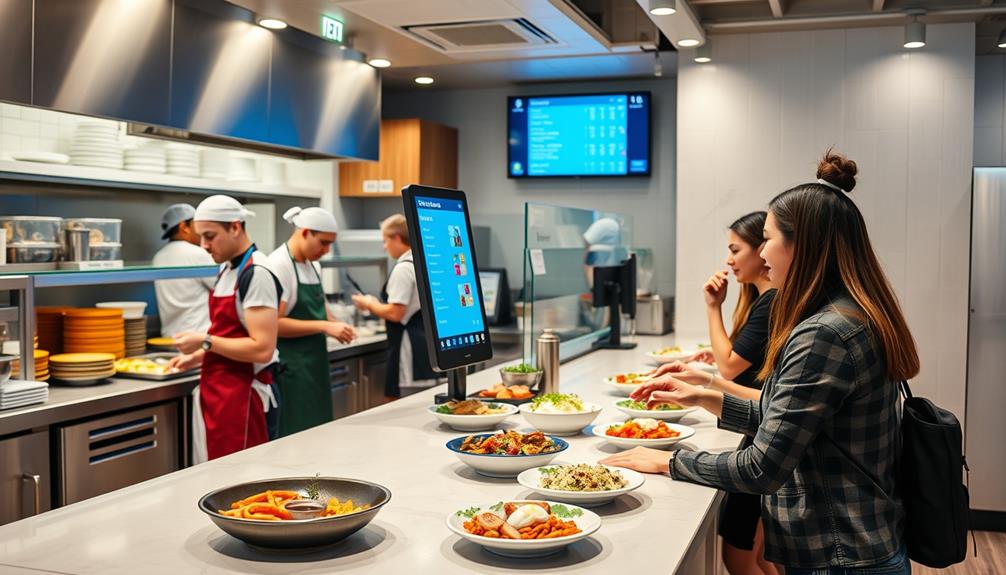
Operating a Quick Service Restaurant (QSR) can lead to impressive revenue potential thanks to high customer turnover and efficient service.
Additionally, many entrepreneurs find that launching a QSR is a best way to earn money online due to its scalability and demand.
You'll also enjoy lower operating costs from smaller spaces and fewer staff, allowing you to maximize profits.
Plus, with the ability to quickly adapt your menu to current trends, you can keep customers coming back for more.
High Revenue Potential
Quick Service Restaurants (QSRs) hold immense revenue potential, making them an attractive choice for entrepreneurs. With profit margins ranging between 6% and 9%, QSRs typically outperform full-service restaurants, providing lucrative opportunities.
The average American family spends about $1,200 annually on fast food, which contributes to the QSR segment's expected growth to $300 billion by 2025. As consumer preferences shift towards convenience and speed, the demand for efficient service and quick meal options continues to rise, making credit card processing vital for maximizing sales.
High customer turnover is a key factor in maximizing revenue. Many QSRs serve thousands of customers daily, greatly boosting sales. Standardized menus streamline operations, allowing for bulk purchasing of ingredients, which can optimize supply chain management and help keep operational costs down.
Moreover, the ability to adapt menu offerings to reflect current food trends keeps your restaurant relevant and appealing. This flexibility enhances customer satisfaction and fosters loyalty, driving repeat business that's essential for sustained revenue growth.
Low Operating Costs
Leveraging smaller dining spaces and a focus on takeout and drive-thru service, Quick Service Restaurants (QSRs) enjoy significantly lower operating costs compared to full-service establishments.
QSRs tend to operate with reduced overhead expenses, as they don't require extensive seating areas. This setup not only minimizes rent but also cuts down on utility costs, making it easier to maintain low prices for customers. The efficient use of resources is critical, much like modern toilet flushing mechanisms that enhance performance while conserving water.
Standardized menus are another key factor. By offering a limited selection, QSRs can purchase ingredients in bulk, leading to lower costs and optimized supply chain management. This enhances operational efficiency, allowing you to serve high volumes of customers daily.
With fewer staff needed, you'll also see reduced labor costs, which boosts profitability. Additionally, the quick service model enables rapid customer turnover during peak hours, maximizing revenue without the need for extensive table service.
The economies of scale that come from serving high volumes allow you to keep competitive pricing while maintaining healthy profit margins, typically between 6% and 9%. Overall, these factors make QSRs a smart choice in today's environment of rising costs.
Flexible Menu Adaptation
The ability to adapt menus quickly gives Quick Service Restaurants (QSRs) a significant edge in a competitive landscape.
With flexible menu adaptation, you can respond to changing consumer preferences, such as the increasing demand for healthier and plant-based options. This adaptability not only helps attract more customers but also keeps your offerings fresh and relevant.
Additionally, QSRs can draw inspiration from seasonal events and local trends in food preferences, much like how thrilling adventures await at water parks during summer.
Here are three key benefits of flexible menu adaptation:
- Limited-Time Offerings: Introducing seasonal menu items creates excitement, as studies show that 63% of consumers are more likely to visit a restaurant featuring these promotions.
- Testing New Items: You can efficiently trial new dishes on a limited scale, minimizing risk while ensuring that only popular items make it to the full menu.
- Capitalizing on Food Trends: By observing regional tastes, you can customize your menu to reflect local flavors, like Taco Bell does, ensuring your QSR stays up-to-date with current trends.
In a saturated market, about 40% of consumers prefer restaurants that frequently update their offerings, making flexible menu adaptation a crucial strategy for success.
Current Trends in the QSR Industry

As the QSR industry evolves, it's clear that consumer preferences are driving significant changes. You might've noticed that the fast-food industry is rapidly adapting to meet demands for convenience and affordability.
With over 61% of consumers ordering delivery or takeout weekly, QSRs account for a whopping 62.6% of these delivery orders. This shift has led to a rise in ghost kitchens, allowing brands to enhance their delivery capabilities without the need for traditional dining spaces.
Additionally, luxury cruises are incorporating unique dining experiences that might inspire QSR innovations. Health-conscious menu options are also becoming more popular, reflecting your desire for healthier eating habits. Many QSRs are now offering plant-based offerings to cater to this trend.
Additionally, the post-pandemic landscape has emphasized the importance of drive-thru and takeout services. You'll find many brands prioritizing speed of service and improving guest experiences to keep up with your expectations.
Online ordering has become a standard expectation, enabling you to enjoy your favorite meals with just a few clicks. These trends signal a significant transformation in how QSRs operate, ensuring they remain relevant and appealing to a growing and diverse consumer base.
Technology in Quick Service Restaurants
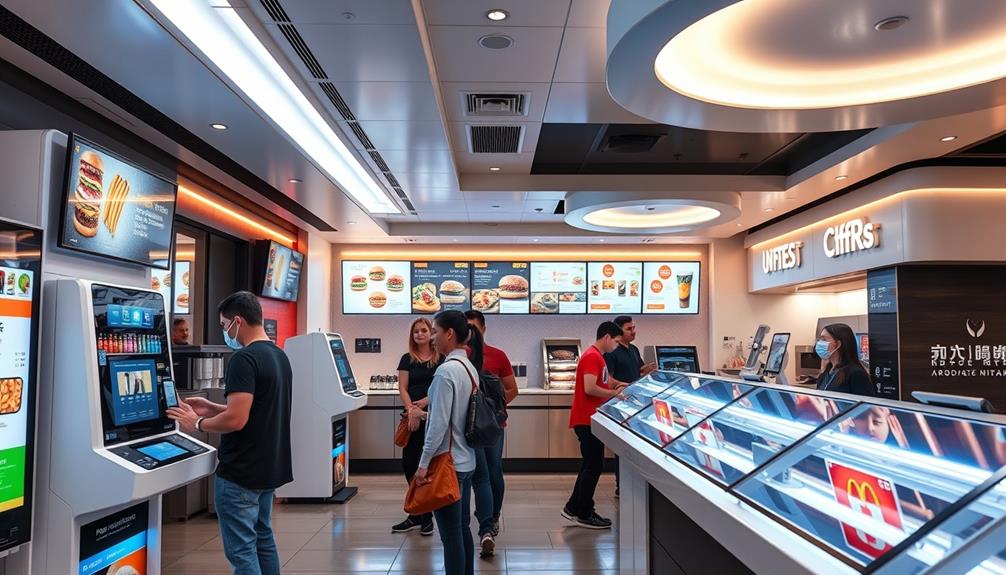
In today's fast-paced world, technology is revolutionizing the way you experience Quick Service Restaurants (QSRs). From the moment you walk in or open an app, innovative solutions enhance your dining experience.
Here's how technology makes a difference:
- Self-Ordering Kiosks: These kiosks allow you to customize your meals without feeling rushed. By doing so, they can increase order values by 20-30%, benefiting both you and the restaurant.
- Mobile Ordering: QSRs are adopting mobile apps that let you place orders on-the-go, boosting convenience and customer loyalty. You can easily manage your orders, making your experience seamless.
- Point of Sale Systems: These systems streamline order processing and payment, greatly enhancing service efficiency. They also integrate with inventory management tools, ensuring ideal stock levels and smoother operations.
Additionally, many QSRs are leveraging AI-assisted data analysis to understand your preferences better and refine menu offerings.
This technological evolution means your experience at Quick Service Restaurants isn't just faster but also more tailored to your tastes. Embracing these innovations keeps your dining experience fresh and enjoyable.
Frequently Asked Questions
What Is the Meaning of Quick Service Restaurant?
A quick service restaurant means you get fast, convenient meals at affordable prices. You order at a counter or kiosk, enjoying a limited menu that prioritizes speed, making it perfect for your busy lifestyle. These types of restaurants also often offer a casual atmosphere, with limited seating and a focus on takeout or quick dining. They are popular in high-traffic areas such as airports, shopping malls, and business districts. In many ways, quick service restaurants embody the definition of popup restaurants, as they provide quick, convenient meals in a limited space, catering to the needs of on-the-go customers.
What Is the Difference Between Fast-Food and Quick Service Restaurants?
You'll find that fast-food restaurants specialize in standardized, low-cost menus, while quick service restaurants offer a broader variety, including healthier options and specialty items, all while maintaining a focus on speed and convenience.
What Is the Meaning of Quick Restaurant?
When you think of a quick restaurant, you're envisioning a place that serves meals rapidly, often with a simple menu. It's all about convenience, affordability, and getting your food without a long wait.
What Are 5 Quick Service Restaurants?
Fast food favorites include McDonald's, Subway, KFC, Burger King, and Starbucks. Each offers quick, convenient choices that cater to various cravings, ensuring you've got plenty of delicious options for your next meal on-the-go.
Conclusion
In the fast-paced world of dining, quick service restaurants have become a go-to for those craving convenience without sacrificing quality. You might find it surprising how these QSRs blend efficiency and flavor, all while adapting to modern trends and technology. As you explore your next meal, consider how these eateries not only satisfy your hunger but also keep up with your lifestyle. It's a coincidence that what you need and want often comes wrapped in a quick service option!
